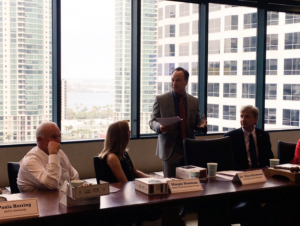June 22, 2016
 The following content is from the June edition of the Business Forecast newsletter, sponsored by Silvergate Bank. To get these updates directly to your inbox, sign up here.
The following content is from the June edition of the Business Forecast newsletter, sponsored by Silvergate Bank. To get these updates directly to your inbox, sign up here.
Business Forecast Highlights:
- BOI moves up a couple points to 21.3
- Poor long-term trends for hospitality and restaurant segment
- Government regulations sapping business confidence
- Overwhelming consensus is that starting a successful business locally is hard work
- Slightly more than half say they would start a new business in County
Survey respondents say starting a business in San Diego County is difficult
Following three months of erratic business confidence, this month’s Silvergate Bank-sponsored Business Forecast shows modest change in outlook among county businesses from last month. San Diego County’s Business Outlook Index (BOI) rests at 21.3, four points below its all-time average of 25.1. As the BOI ranges from -100 to +100, with zero being neutral, the business community’s outlook does remain moderately positive.

(click for larger image)
Looking at long-term trends affecting the outlook, there is evidence of specific impacts by industry and geography. The hospitality and restaurant industry has shown a year-long trend of a weaker outlook which has weighed down local economic sentiment. Geographically, the long-term decline has come from county businesses located outside the City of San Diego.
The short-term trends show that the BOI has recently been flat. Firms in Santee are the notable exception, as confidence there has grown. For members of the Santee Chamber of Commerce, the BOI has moved from a lackluster 12 in the previous quarter to a robust 40 this month.
Minimum wage increases remain the top challenge facing County businesses, as 9 percent mention them. Government regulations in general, changes in the political environment, taxes, and the Affordable Care Act combine to affect another 14 percent. This means that more than one out of every five San Diego County businesses see government as a barrier to success. That takes a toll on business confidence. Those citing government as a challenge report a BOI of 16 and those specifically citing regulations as the challenge post a BOI of only 3.
Last month we saw that sentiment related to hiring was a critical factor dragging down the BOI. This month, hiring, at least among large companies, has rebounded. However, small firms are not nearly as likely to add workers.
This month’s survey asked about business start-ups finding that the consensus is it takes a lot of effort to get a good business off the ground in San Diego County. Seventy-four percent of business people say it’s difficult to start a successful company in their area and 30 percent describe it as very difficult. Only 19 percent rate the process as easy.

(click for larger image)
Two types of businesses that don’t share the dismal outlook of starting a business are home and garden, and healthcare related companies. Companies in these industries rarely rate starting a business as very difficult. Also, businesses located in the county’s south suburbs tend to be split on the ease of setting up shop successfully. What is interesting is that we find no correlation between how confident a business person is and their perception of the difficulty of starting a company.
When it comes to where to start a new business, opinions are as varied as the options. Likely reflecting a physical tether to the County, a slim majority would start a new company here. However, only 32 percent would start that company in their own city or town. Only 6 percent would look to somewhere else in the state, but another 23 percent would start that company outside of California. There are 15 percent who say, under no circumstance, would they start a new business.

(click for larger image)
ABOUT THE BUSINESS FORECAST
The San Diego County Business Forecast, sponsored by Silvergate Bank, is a scientific look at where our region’s economy is headed. The survey for this month’s installment was fielded May 16-31, 2016 by Competitive Edge Research & Communication using responses from 232 randomly-selected members of the San Diego, East County, Alpine, Escondido, Lakeside, Vista, Santee, and National City Chambers of Commerce. All Chamber members are invited to complete the survey either online or over the phone.
The Business Outlook IndexTM (BOI) is comprised of four self-reported assessments regarding the next three months: Will a respondent’s business increase or decrease its number of employees, experience an increase or a decrease in revenue, increase or decrease the number of hours its employees work, and experience an improvement or a worsening of business conditions. For each assessment, definite and positive responses are scored 100, probable and positive responses are scored 50, neutral responses are scored 0, probable and negative responses are scored -50 and definite and negative responses are scored -100. The scores are summed and divided by 4 to get a range for the BOI of -100 to +100, with zero being a neutral outlook. Visit https://sdchamber.org/businessforecast to see past Business Forecasts.
ABOUT SILVERGATE BANK,BUSINESS BANKING REDEFINED
For over 25 years, as a San Diego based community bank, Silvergate provides a rewarding banking experience where the client’s needs always come first. Our business banking experts listen to needs and work to provide customized solutions to support your company’s growth and profit objectives. Our bankers are committed to superior responsiveness, local decision making, and the agility that allows our clients to choose the way they want to bank with us. To learn more, visit www.silvergatebank.com or contact Dino D’Auria at ddauria@silvergatebank.com.







